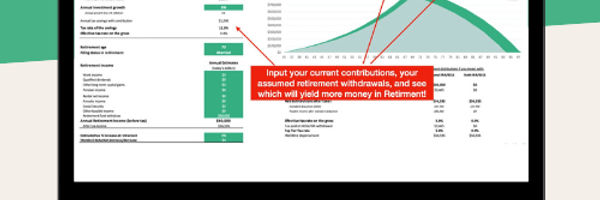Keogh plans allow self-employed individuals, or small businesses, the opportunity to provide employees with retirement savings benefits. Keogh plans are sometimes referred to as qualified plans, or HR10 plans, and their rules are quite different from those that apply to Individual Retirement Accounts (IRA).

Roth IRA or 401k? This template will answer your questions.
With this template, you will get:
All DFY, simply add your details
Charts for comparison and clear answer
Easily update for any year (2023, 2024, 2025, etc…)

Keogh Plans
Keogh plans were created so that self-employed individuals, or employees working for small companies, had the opportunity to put money aside each year to use in retirement. This type of account allows small businesses to offer their employees retirement planning benefits similar to those of larger corporations.
Contributions to Keoghs
Contributions to Keogh accounts are made on a tax-deductible basis, and the earnings grow tax-free until withdrawn. Although there are many possible variations from which to choose, there are two broad categories into which all Keogh plans fall:
Defined Benefits Plans
Defined Contributions Plans
Defined Benefit Plans
With a defined benefit plan, an employee receives a pre-determined benefit, as calculated using a specific formula. This benefit is usually tied to the employee's length of service, annual earnings, or a combination of the two.
Defined benefits plans are preferred by more senior employees because they favor the employee's length of service. While the employer does have some flexibility when it comes to contributing to their fund, most of the factors determining their contributions are fixed.
Defined benefits plans also allow employers the opportunity to quickly shelter income from taxes, but that advantage comes at a cost. This type of plan is typically more complex to administer, and often requires the services of actuaries to perform the funding calculations.
Defined Contributions Plans
Defined contribution plans are sometimes referred to as individual account plans. With this type of Keogh, the plan will specify the exact amount of funds placed into an employee's account. The accumulated funds in the employee's account, as well as the investment's gain or loss, determine the benefit received at retirement.
Within the category of defined contribution plans, there are several sub-plans including:
Simplified Employee Pensions (SEP)
Profit Sharing Plans
Money Purchase Plans
401(k) Plans
Simplified Employee Pensions
The simplified employee pension (SEP) plan is arguably the easiest retirement plan for a small business to put into practice. The plan requires very little paperwork, is extremely flexible, and does not require the approval of the IRS.
SEPs work very much like Individual Retirement Accounts. But unlike Traditional IRA contributions, the limits are much higher as explained later on. Typically, employees can defer 15% to 25% of annual earnings into this type of Keogh.
In general, contributions are made on a nondiscriminatory basis to all employees that have reached age 21 or older. These employees need to have worked any part of three of the past five years. Employers can vary contributions from year-to-year, and the payment is due when filing that year's income tax return. Once a contribution is made, the funds are considered owned by the employee.
One variation of the SEP is the Salary Reduction SEP, or SAR-SEP. With this type of retirement plan, employees are allowed to set aside a portion of their pay on a pre-tax basis. Deferred contributions to a SAR-SEP can be excluded from the employee's gross income when calculating federal income taxes due. SAR-SEPs are allowed only if the employer has fewer than 25 employees during the preceding year.
Complete specifications for the SEP plans can be found in IRS Form 5305. In fact, that same form also provides a template for structuring this type of Keogh plan.
Profit Sharing Plans
Profit sharing plans arguably offer employers the most flexibility. Contributions can be based on compensation, or a flat amount can be offered to all eligible employees. Most of the time, contributions into the profit sharing plan take place when the company is profitable, although the company can decide to fund the plan even if a loss occurs.
Unlike a SEP, a profit sharing plan allows employers to apply a vesting schedule to the company's contributions. Profit sharing plans also allow employers to exclude part-time workers. Participants can also take loans against the vested funds in their plan.
Money Purchase Plans
A money purchase plan allows the employer to contribute a fixed percentage of the employee's compensation to the plan each year. The percentage contributed cannot exceed 25% of the employee's earned income, with a maximum allowable contribution as explained below.
With a money purchase plan, the contribution percentage must be the same for all eligible employees, and is paid into the plan even if the company does not show a net profit for the year. Unlike some of the plans discussed earlier, a money purchase plan does not provide for integration with Social Security, which allows employers to set aside more money to individuals earning over the Social Security maximum wage base.
401(k) Plans
We've written extensively about 401(k) plans elsewhere on this website. The idea behind a 401(k) plan for a small business remains consistent with that information. They offer employees a chance to set aside a percentage of their compensation on a before-tax basis through regular payroll deductions.
Employers normally provide what is called discretionary matching contributions to help increase participation in the plan, as well as providing employees with an added financial benefit. All 401(k) plans, regardless of their size, need to pass several nondiscrimination tests, or the deferrals made by highly-compensated employees may be limited.
Contribution and Deduction Limits
One of the more compelling features of Keoghs is the relatively high maximum contributions allowed. The contributions themselves can be made on a before-tax basis, and grow on a tax-deferred basis until withdrawn at retirement. Withdrawals from Keogh accounts are then taxed as ordinary income.
The exact contribution limit for an account depends on the employee's participation in other retirement plans. For example:
Keogh Plans Only: if someone is self-employed, and the Keogh account is their only retirement plan, their contribution limit is $57,000 or 100% of eligible compensation, whichever is less for the tax year 2020. In 2021, the contribution increases to $58,000. The maximum deductible contribution is limited to 25% of their eligible compensation.
403(b) and Keogh Plans: if someone participates in both a 403(b) plan and a Keogh plan, then the contributions made to both plans cannot exceed $57,000 or 100% of eligible compensation, whichever is less for the tax year 2020. In 2021, the contribution limit increases to $58,000.
Qualified Plans and Keogh Plans: if someone participates in both a qualified plan and a Keogh, the contribution limits for each plan are calculated together. The maximum allowable contribution to each plan is $57,000 or 100% of eligible compensation, whichever is less for the tax year 2020. Once again, this limit increases to $58,000 in 2021.




